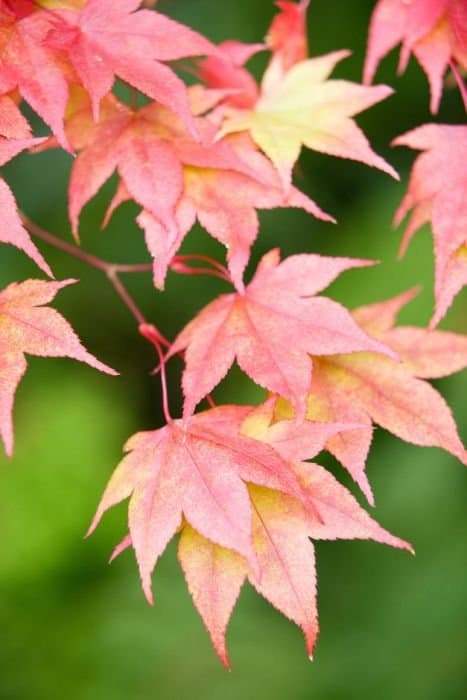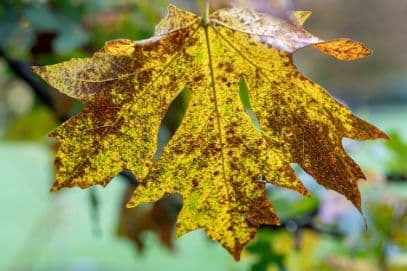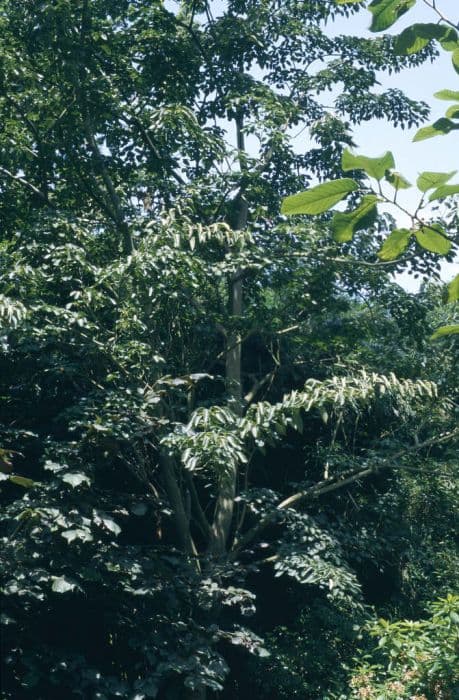Japanese Maple Acer palmatum 'Tamukeyama' (D)

ABOUT
Acer palmatum 'Tamukeyama' is best known as the Japanese maple 'Tamukeyama'. This plant is favored for its elegant, cascading form and finely cut, lace-like leaves that provide a delicate appearance. Its foliage is deeply lobed, resembling the palm of a hand, with slender fingers radiating outwards. Each leaf typically has five to seven pointed lobes, which contribute to the plant's intricate texture. The leaves emerge a striking crimson-red in the spring, and as they mature, they turn to a rich, dark purplish-red which beautifully contrasts with the plant's smooth, gray bark. The foliage retains this deep color remarkably well throughout the summer. When autumn arrives, the Japanese maple 'Tamukeyama' puts on a spectacular show, with leaves transitioning to a bright red or even shades of orange and gold, characterizing the vibrant, fiery displays for which Japanese maples are celebrated. This plant often develops a rounded, dome-like canopy as it matures, draping towards the ground with its weeping branches, creating an overall graceful and sculptural form. The intricate foliage, color transitions, and graceful structure make the Japanese maple 'Tamukeyama' a prized specimen for visual interest in various garden settings.
About this plant
 Names
NamesFamily
Aceraceae
Synonyms
Tamukeyama Japanese Maple, Tamukeyama Red Japanese Maple, Tamukeyama Laceleaf Japanese Maple
Common names
Acer palmatum 'Tamukeyama'
 Toxicity
ToxicityTo humans
The Japanese maple is generally not considered poisonous to humans. However, as with many plants, it may cause irritation or allergic reactions in sensitive individuals. There are no well-documented cases of poisoning from ingestion of this plant, so it is generally not regarded as toxic. If any part of the plant was ingested and there is a concern, it is advisable to contact a medical professional.
To pets
The Japanese maple is not listed as toxic to pets. It is generally considered safe for dogs and cats, and there are no widely recognized symptoms of poisoning in pets from ingestion of this plant. However, individual animals may have different sensitivities, and ingestion of any plant material can potentially cause gastrointestinal upset, such as vomiting or diarrhea, especially if ingested in large quantities. If you suspect your pet has ingested a substantial amount of this plant and is showing signs of distress, please consult your veterinarian.
 Characteristics
CharacteristicsLife cycle
Perennials
Foliage type
Deciduous
Color of leaves
Red
Height
6-8 feet (1.8-2.4 meters)
Spread
8-12 feet (2.4-3.7 meters)
Plant type
Tree
Hardiness zones
5-9
Native area
Japan
Benefits
 General Benefits
General Benefits- Ornamental Appeal: Offers finely cut burgundy-red leaves that turn crimson in fall, adding aesthetic value to landscapes.
- Compact Size: Suitable for small gardens due to its slow-growing, compact nature, reaching an average of 6-8 feet.
- Shade Tolerance: Thrives well in partial shade, providing design flexibility in garden planning.
- Seasonal Interest: Provides year-round interest with changing foliage colors and attractive winter bark.
- Low Maintenance: Requires little pruning and is relatively free of pests and diseases, reducing the need for chemicals.
- Drought Tolerance: Once established, it can withstand periods of low water, making it suitable for xeriscaping.
- Wildlife Attraction: Attracts birds and beneficial insects, promoting biodiversity in the garden.
 Medical Properties
Medical PropertiesThis plant is not used for medical purposes.
 Air-purifying Qualities
Air-purifying QualitiesThis plant is not specifically known for air purifying qualities.
 Other Uses
Other Uses- Japanese maple 'Tamukeyama' can be employed in bonsai culture, where their natural elegance and responsiveness to pruning make them an excellent choice for creating miniature landscapes.
- The smooth, textured bark of the Japanese maple can be used in photography and art projects focusing on natural textures and patterns.
- Japanese maple's branches and foliage can be used in floral arrangements or as a natural decor to add a touch of autumn color to indoor settings.
- In landscaping, this plant is often used as a focal point in zen and Japanese garden designs, integrating tranquility and aesthetic beauty.
- The cascading growth form of Japanese maple can be implemented in creating living walls or privacy screens in garden settings.
- The leaves of Japanese maple can be incorporated into craft projects, such as leaf pressing or creating botanical prints.
- Dried leaves of Japanese maples can be used to create natural dyes for fabric or artisanal paper products.
- The distinctive shape and seasonal color changes of the Japanese maple can inspire design elements in architecture, fashion, or graphic design.
- Woodworkers or artisans can use fallen branches and wood of Japanese maple for creating small woodcrafts or decorative objects.
- Fallen Japanese maple leaves can be used as a natural mulch, providing a nutrient-rich cover for the soil and adding aesthetic value to garden beds.
Interesting Facts
 Feng Shui
Feng ShuiThe Japanese maple is not used in Feng Shui practice.
 Zodiac Sign Compitability
Zodiac Sign CompitabilityThe Japanese maple is not used in astrology practice.
 Plant Symbolism
Plant Symbolism- Beauty: The intricate, lace-like leaves and the plant's elegant habit symbolize aesthetic beauty and grace.
- Endurance: Being a hardy plant that can live for hundreds of years, Japanese Maple represents endurance and strength.
- Balance: The harmonious shape and seasonal color changes of Japanese Maple are often seen as a symbol of balance and calm.
- Peace: The serene and tranquil presence of Japanese Maples in gardens is believed to symbolize peace and tranquillity.
- Change: With leaves that change color through the seasons, Japanese Maple reflects the concept of change and the impermanence of life.
 Water
WaterThe Japanese maple 'Tamukeyama' should be watered deeply once a week, making sure to soak the soil thoroughly until water begins to run from the drainage holes in the pot. Increase watering to twice per week during hot or dry periods, ensuring it receives about 1.5 gallons each time to maintain even soil moisture. Over-watering can lead to root rot, so it's crucial to allow the soil to dry slightly between waterings. During winter when the tree is dormant, reduce watering to when the soil appears dry to the touch. Consistency is key to avoid stress on the tree.
 Light
LightJapanese maple 'Tamukeyama' prefers a location where it can receive morning sun and afternoon shade to protect it from the harsh midday sun, which can scorch its delicate leaves. Dappled sunlight under the canopy of larger trees is ideal, providing sufficient light without the intensity of direct sun during the hottest part of the day. Such conditions mimic the tree's natural environment and help to foster vibrant foliage coloration.
 Temperature
TemperatureThe 'Tamukeyama' Japanese maple thrives in a range of temperatures, with its ideal growing conditions between 60°F and 70°F. It can withstand minimum temperatures down to -20°F once established, making it hardy in many climates. During the winter, providing protection from harsh winds can help to prevent damage to the branches and foliage.
 Pruning
PruningPruning the Japanese maple 'Tamukeyama' helps to maintain its shape, remove dead or damaged branches, and encourage healthy growth. The best time to prune is in late winter or early spring before new growth begins. Light pruning can be done throughout the year, but major cuts should be done during the dormant season. Remove crossing branches and thin the canopy to allow light and air to penetrate, which helps to reduce the risk of disease.
 Cleaning
CleaningAs needed
 Soil
SoilThe best soil mix for the Japanese Maple 'Tamukeyama' should be well-draining and acidic with a pH range of approximately 5.5 to 6.5. A mix containing one part peat, one part pine bark, and one part coarse sand or perlite is often recommended.
 Repotting
RepottingJapanese Maple 'Tamukeyama' should generally be repotted every two to three years to refresh the soil and to address any potential root-bound issues. It's best done in late winter or early spring before the growth season begins.
 Humidity & Misting
Humidity & MistingJapanese Maple 'Tamukeyama' prefers moderate humidity levels but is adaptable to various conditions provided it is not in a continuously dry environment. Avoid placing it in excessively dry climates or areas with hot, drying winds.
 Suitable locations
Suitable locationsIndoor
Place in bright, indirect light, shield from harsh sun.
Outdoor
Partial sun, sheltered from harsh conditions.
Hardiness zone
5-8 USDA
 Life cycle
Life cycleThe Japanese Maple 'Tamukeyama' begins its life as a seed, which germinates in favorable conditions of moisture and temperature to develop into a seedling. The seedling grows through a juvenile phase, increasing in size and developing characteristic deeply lobed, purple-red leaves. As it matures, the maple enters a vegetative stage, characterized by robust stem and leaf growth, and establishes a strong root system. After several years, it becomes a mature tree, capable of producing flowers in spring which are followed by the development of samaras, or winged seeds, that disperse for reproduction. This acer experiences a period of dormancy in winter, when it loses its leaves and conserves energy until the warmer temperatures of spring initiate a new cycle of growth. Throughout its lifetime, the 'Tamukeyama' may undergo pruning and shaping, which is common for ornamental varieties, to maintain its desired weeping form and to encourage healthy foliage production.
 Propogation
PropogationPropogation time
Early spring
The most popular method for propagating the Japanese Maple 'Tamukeyama' is by softwood cuttings. This technique is usually performed in late spring or early summer when the new growth is still tender and green. A cutting of about 6 to 8 inches (15 to 20 centimeters) is taken from a healthy parent plant, ensuring that it includes at least two or three sets of leaves. The lower leaves are removed and the cut end is dipped in rooting hormone to enhance root development. The cutting is then planted in a well-draining potting mixture, making sure to keep the soil moist but not waterlogged. A plastic cover can be placed over the cutting to maintain high humidity, which is critical for successful rooting. After several weeks, the cutting should develop roots and can be transferred to a larger pot or planted directly in the garden.








